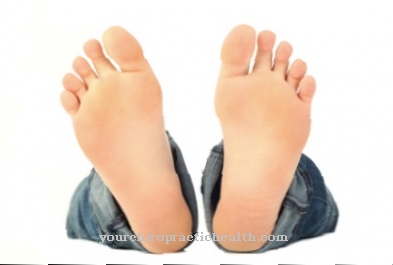The following article describes the causes, diagnosis, and treatment pale skin. In addition, it explains which strategies can be used to achieve the best possible prevention.
What is pale skin

In medicine, pale skin is a physical complaint in which a patient complains about a significant change in skin color. If you are pale, it looks lighter and less lively than usual.
It should be noted that the concept of pallor in medicine is separated from the characteristic of a light skin type. The paleness is always a complaint that may even indicate possible underlying diseases. On the other hand, one speaks of a light skin type if this is also the patient's normal skin color.
Since paleness affects different people differently, there is no general definition. It is also hardly possible for a doctor to recognize paleness in a new patient himself. Instead, changes are most recognized by the patient himself. The same applies to friends and acquaintances. Changes in skin color are most noticeable on the face and arms.
causes
Pale skin can be attributed to different causes. One of the best known causes is fright. In a shock situation, blood is transferred from the face to the internal organs. The body's own mechanism is intended to increase the person's defense potential.
Paleness can also occur if there is severe blood loss. This is the case, for example, after an accident or a bleeding stomach ulcer. Short-term paleness occurs when blood pressure suddenly drops. On the other hand, people suffer from chronic paleness if they have hypotension (low blood pressure) or anemia (anemia).
Smoking is another cause. The narrowing of blood vessels leads to insufficient blood flow in the face and hands. In addition, there are numerous diseases that result in pale skin. These can be infections, organ damage or tumors.
You can find your medication here
➔ Medicines for pale skinDiseases with this symptom
- Coronary heart disease
- Circulatory disorders
- leukemia
- Iron deficiency
- Hypothermia
- poisoning
- eating disorder
- Diabetes mellitus
- anorexia
- Renal failure
- Alcohol poisoning
- allergy
- Vitamin B12 deficiency
- Anemia
- Arterial Disease
- Low blood pressure
- Anemia
- Circulatory problems
Diagnosis & course
If pale skin appears for no apparent reason, it is advisable to consult a general practitioner or dermatologist. At the beginning, the doctor asks in a detailed discussion when the paleness becomes noticeable. In addition, it collects important data on previous and existing illnesses.
In addition, the doctor should be informed if medication is taken or drugs are consumed. Complaints such as fatigue or loss of appetite should also be mentioned. The doctor then asks further questions about diet and leisure activities. This is accompanied by a physical exam that measures blood pressure, examines heart function using an EKG, and checks blood values.
If pale skin persists, additional tests will be done. This includes an exercise ECG, an ultrasound examination and a bone marrow diagnosis. If the pallor continues to appear despite the diagnosis and associated therapy, it is referred to as a chronic disease.
Complications
Pale skin is not in itself a disease, but can be part of the phenotype of a healthy person. However, pale skin can cause health problems that a person with darker skin would not. Sunburn is one of them, because lighter skin tones have less melanin - this is not only the skin pigment, but also its natural protection against UV radiation.
Every sunburn is uncomfortable, but at the same time it creates the basis for skin cancer. The risk does not depend on the number of times sunburn has occurred; theoretically, cell degeneration can occur with every sunburn. So-called melanoma can develop in the long term. Pale skin not only carries an increased risk of cancer as a result of sunburn, it can also be a sign of disease - but it is often overlooked as many people have pale skin if they are not outside all day.
A newly created pallor can mean that not enough nutrients from food can be metabolized. Most of the time it is about iron, so it is called anemia. A change in skin tone to pale can also mean thyroid problems. We are talking about mixed edema, as the skin not only becomes pale, but also structurally different. Skin changes are often not recognized as symptoms and therefore go unnoticed.
When should you go to the doctor?
From a medical point of view, pale skin has nothing to do with type-related light skin. When doctors talk about pale skin, they mean it as a symptom. When a doctor sees a patient with pale skin for the first time, he often lacks the previous appearance for a binding assessment. An exception would be skin that is described as pale as chalk, as it occurs in states of shock or high blood loss. Relatives and friends can give helpful tips on pale skin here. It is different with the family doctor: He already knows his patient and can assess the current skin tone.
In addition to shock and blood loss, hypothermia, a drop in blood pressure, chronically low blood pressure and anemia also play important roles in pale skin. The pale skin of many smokers is also known. Heart disease and, in rare cases, thyroid problems are also possible causes of pale skin.
Anyone who has had pale skin all their life and feels good about it does not need to see a doctor. This looks different with recently pale skin, especially if there are other symptoms such as poor appetite and fatigue. The family doctor is the ideal contact person for pale skin. If necessary, he will be referred to specialists such as internists or cardiologists for further clarification.
Doctors & therapists in your area
Treatment & Therapy
The diagnosed cause plays an important role in treatment. If a source of bleeding (e.g. gastric ulcer) has been found, it must be treated immediately. If, on the other hand, pale skin is associated with malnutrition, a nutrition plan is drawn up and nutritional supplements are prescribed.
Treatment is more difficult if there is an underlying disease. In this case, pale skin can only be counteracted if the underlying disease is recognized and treated. This is made more difficult if the disease is chronic. Examples are hypotension and anemia. The treatment of pallor is also difficult if it is caused by leukemia (cancer). With chemotherapy and radiation therapy, paleness is a natural consequence.
If, on the other hand, pale skin can be traced back to a longstanding smoking habit, then smoking must first and foremost be stopped. With medication, on the other hand, it is only possible to remove pallor for a short time. These are drugs that assume an effect of increasing blood pressure.
Appropriate agents should only be used according to the instructions of the dermatologist or general practitioner. If you want to counteract the paleness in the long term, the underlying cause must first be treated.
Outlook & forecast
Pale skin can be perfectly normal for one person while it is a symptom of a disease in another. If pale skin appears in healthy people, it has no disease value and therefore no prognosis. Nevertheless, sun protection is very important in these cases, as otherwise sunburn can occur and skin cancer can develop from this in old age. Darker skin types, on the other hand, are better protected due to their increased melanin content.
If pale skin appears as a new phenomenon, however, this can certainly have a disease value. Often times, pale skin is just an initial symptom, and the affected patient will notice other signs that something is wrong in the near future. However, it can take a while to figure out on your own that pale skin and other new symptoms are related.
When treatment begins - for example in the case of iron deficiency or anemia - it often takes a long time for pale skin to return to normal. In these cases it is of little help to lie in the sun more often. The skin turns brown over time, of course, but in its pale state it is also at risk of sunburn. It is better to pay attention to good sun protection and a healthy diet during this time, which will help to permanently eliminate the cause of pale skin.
You can find your medication here
➔ Medicines for pale skinprevention
There are several strategies that can be used to prevent pale skin. First of all, it is important to pay attention to a balanced diet. Undisturbed sleep also plays an important role.
In addition, the consumption of tobacco, alcohol and drugs should largely be avoided. It is also important to exercise regularly. Usually it is enough to go jogging or swimming. The movement and the oxygen-rich air take on a positive effect.
It is also advisable to have your blood values checked at regular intervals. Individual cancer screening should also be considered.
You can do that yourself
If the symptom of pale skin is not caused by a serious disease, numerous home remedies can help. Experience has shown that pale skin is due to an iron deficiency. This can be remedied by getting enough iron. Commercially available iron supplements are only rarely necessary because a large number of foods contain iron. Millet, soy and oats are suitable for consumption. Rye, chickpeas and white beans also contain a considerable amount of iron.
Medicinal plants can also be used for pale skin. Herbs such as nettles or dandelions can be used in their pure form or as a tea or salad. Natural sources of iron also include juices made from raspberries or currants.Cherry, grape and pomegranate juice are equally recommended for pale skin.
Pale skin is also often caused by low blood pressure. However, drugs are rarely required. To stabilize blood pressure and reduce paleness, simple methods such as exercise, relaxation, and adequate fluid intake help. Also noteworthy are hydrotherapy applications according to Sebastian Kneipp. First and foremost, the cold arm bath should be mentioned. This application stimulates blood pressure and is refreshing. However, those affected should only use this application after receiving precise instructions.

.jpg)


.jpg)



















.jpg)



